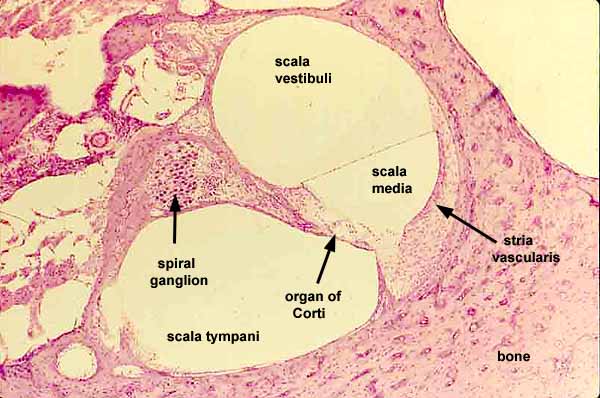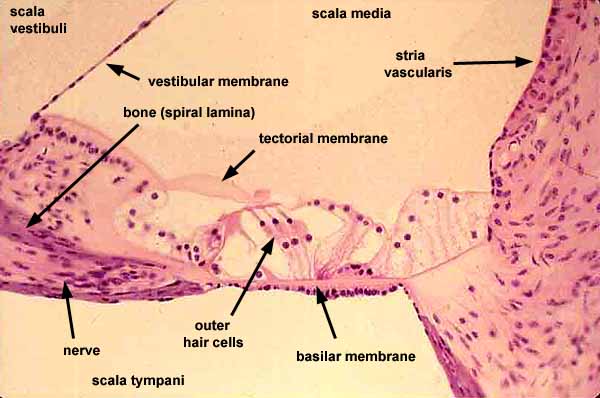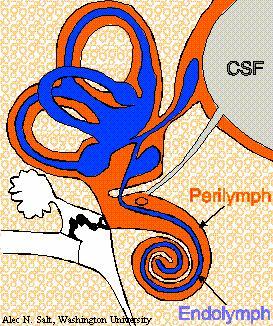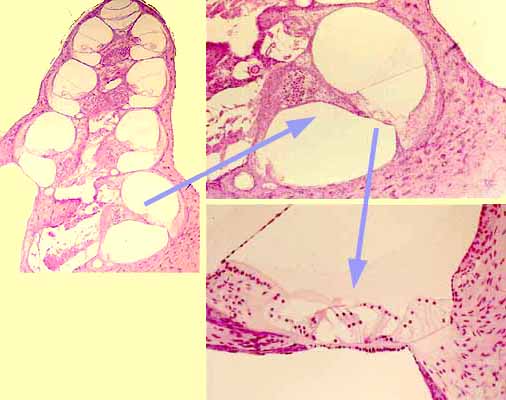REGIONS of the ear
The ear has three distinct regions -- outer ear, middle ear, and inner ear.
- The outer ear includes the pinna (the visible ear, consisting
mostly of skin and cartilage)
and the ear canal. The latter is lined by keratinized
stratified squamous epithelium. This lining differs from skin
by the presence of specialized ceruminous (ear-wax) glands.
- The middle ear is basically a space, communicating via the eustacian
tube with the oropharynx. It is lined by a very thin non-keratinized
stratified squamous epithelium. Spanning the space of the middle
ear are the three middle ear bones, the malleus (hammer), incus
(anvil), and stapes (stirrup).
- The eardrum is a thin membrane separating the outer ear from the middle
ear. It is sandwich of tissues, with keratinized stratified squamous
epithelium facing the outer ear, non-keratinized stratified squamous epithelium
facing the middle ear, and a very thin layer of connective tissue in between.
- The inner ear is the portion of the ear which contains sensory
receptors. The remainder of this study guide describes the inner ear.
TOP OF PAGE
OVERVIEW of the INNER EAR
The inner ear has a complex structure. The following basic concepts
should help organize that complexity.
TOP OF PAGE
BONY LABYRINTH and MEMBRANOUS LABYRINTH
 |
Image courtesy Alec Salt, used with permission.
|
The inner ear resides within a space called the bony labyrinth.
- The oval window forms a potential opening from the middle ear into
the bony labyrinth.
- The stapes of the middle ear plugs this opening; but . . .
- The stapes is flexibly attached and can vibrate to transmit
pressure waves to the fluid that fills the bony labyrinth.
(Sound is carried from the eardrum across the middle ear by the three middle ear
ossicles, ending with the stapes at the oval window.)
Suspended within the bony labyrinth, and approximating its shape, is an interconnected
set of membrane-lined chambers and passageways called the membranous labyrinth.
- In the diagram at right, the color orange
occupies the space of the bony labyrinth, while the membranous
labyrinth is blue.
- The name labyrinth suggests the complex shape of these chambers
and passageways.
- The vestibule is (logically enough) the "entry room"
into the deeper passageways.
- The vestibule of the bony labyrinth contains the saccule
and the utricle of the membranous labyrinth;
- Three semicircular canals comprise looping
tubules which leave and return to the vestibule.
- The saccule, the utricle, and the semicircular canals together comprise the vestibular system.
- The cochlea is shaped like a snail-shell which
spirals away from the vestibule.
- A single coiled tunnel of the bony labyrinth is subdivided into
three levels ("scalae") by membranes of the membranous
labyrinth.
- The portion of the membranous labyrinth within the cochlea
is called the scala media.
- The scala media of the cochlea is connected to the saccule by the ductus reuniens, or Hensen's duct [after
Victor Hensen, b. 1835].
The membranous labyrinth is filled with a unique fluid called endolymph
(blue in diagram).
Surrounding the membranous labyrinth (i.e., filling the remaining space
of the bony labyrinth) is a fluid called perilymph (orange in diagram).
TOP OF PAGE
HAIR CELLS
Hair cells are the specialized mechanoreceptor cells of the auditory
and vestibular systems. Hair cells are found in several positions along the chambers
and passageways of the membranous labyrinth.
- Hair cells are basically columnar epithelial cells.
- At the apical end of each hair cell is a set of "hairs" (cytoplasmic
projections, kinocilium and stereocilia) embedded in a
mass of extracellular jelly.
- At the basal end of each hair cell are synapses onto sensory axons.
- Hair cells work similarly throughout the inner ear.
- A hair cell responds when movement of the extracellular jelly displaces
its kinocilium and stereocilia. Displacement is excitatory in
one direction (toward the kinocilium) and inhibitory in the opposite
direction.
- Displacement of the kinocilium and stereocilia alters conductance
of ion channels, in turn affecting release of neurotransmitter onto
the associated sensory axon. (These axons project along the auditory
and vestibular nerves, cranial nerve VIII).
- Hair cells function within a fluid environment, the endolymph,
with a unique ionic composition.
- The process of sensory transduction in hair
cells (i.e., the conversion of an external stimulus, in this case small
movement, into neural activity) has been intensively investigated.
For detailed information, consult your print resources (e.g., Kandel
et al.)
- The mechanical disposition of the jelly in relation to the spaces of the
membranous labyrinth determines how hair cells respond.
TOP OF PAGE
OTOLITH ORGANS (SACCULE and UTRICLE)
 The
saccule and utricle contain patches of hair
cells called maculae ("macula" means "spot"
or "patch").
The
saccule and utricle contain patches of hair
cells called maculae ("macula" means "spot"
or "patch").
- A small mass of jelly rests on top of the hair cells of the macula.
- In this jelly are numerous tiny mineral concretions, called otoliths
("earstones" or "earsand").
- Clinical Note: If any otoliths break
loose (e.g., due to head trauma), they may come to rest in an
inappropriate place, stimulating the hair cells in a semicircular canal)
and cause disturbance in balance (e.g., see
benign paroxysmal positional vertigo, or BPPV).
- Hair cells of the macula are deflected by the
weight or inertia of the otoliths. Together the two pairs of otolith organs
(one of each in each ear) can sense head orientation (gravity) or linear
acceleration in any direction.
 |
| Image courtesy Alec Salt, used with permission. |
TOP OF PAGE
SEMICIRCULAR CANALS
 Each
semicircular canal of the bony labyrinth is a hollow passageway looping out from and back to the vestibule. Within
each of these passageways is a semicircular canal of the membranous
labyrinth.
Each
semicircular canal of the bony labyrinth is a hollow passageway looping out from and back to the vestibule. Within
each of these passageways is a semicircular canal of the membranous
labyrinth.
- At one end of each membranous semicircular canal is a small enlargement
called the ampulla.
 Within
each ampulla is a ridge or "crest" called the crista.
Within
each ampulla is a ridge or "crest" called the crista. - The crista is covered with hair cells.
- A small mass of jelly, called the cupola ("cap") rests
on top of the hair cells of the crista.
Hair cells of the ampullae respond to angular
acceleration (i.e., rotation of the head).
- There are three semicircular canals in each ear, oriented in three mutually-perpendicular
planes.
- Rotation of the head in any direction will cause inertial fluid movement
in one or more of the semicircular canals.
- Fluid motion in a semicircular canal pushes the the cupola like a swinging
door.
- Movement of the cupola in turn deflects the projections of the hair
cells.
Clinical Note: Should loose otoliths
enter a semicircular canal, they may stimulate the hair cells inappropriately
and cause disturbance in balance (see benign
paroxysmal positional vertigo, or BPPV).
The planes of orientation of the semicircircular canals correspond to the
planes of action of the extraocular muscles, allowing simple reflexes to coordinate
eye movement with head rotation. (Amazingly, at least to this writer, this
correspondence has been maintained through evolution even while position and orientation
of both eyes and ears have been modified.)
 |
Image courtesy Alec Salt, used with permission.
|
TOP OF PAGE
 COCHLEA
COCHLEA
The cochlea houses an elaborate configuration of membranous
labyrinth and hair cells, called the organ
of Corti, designed for auditory reception.
The basic shape of the cochlea is that of a snail-shell, or tapering helix.
NOTE: The human cochlea is short and broad, with fewer
turns than shown here. Micrographs at this
website (as well as in many other references) show the cochlea of a laboratory
rodent which is proportionately taller and narrower.
 The
spiraling tunnel (blue, in image at right)
that forms the cochlea of the bony labyrinth is divided
into three distinct channels by portions of the membranous
labyrinth attached to bony ridges. Each of these channels is called
a "scala," meaning "ramp" or "incline"
(think of a musical "scale").
The
spiraling tunnel (blue, in image at right)
that forms the cochlea of the bony labyrinth is divided
into three distinct channels by portions of the membranous
labyrinth attached to bony ridges. Each of these channels is called
a "scala," meaning "ramp" or "incline"
(think of a musical "scale").
- The scala vestibuli ascends from the vestibule
(hence vestibuli in the name) to the tip of the cochlea.
- The scala vestibuli contains perilymph.
- At the tip of the cochlea, the scala vestibula connects to the scala tympani at the helicotrema.
- The scala tympani descends from the tip of the cochlea to the round
window. (There is an elastic energy-dissipating membrane covering
the round window (hence tympani in the name).
- The scala tympani, like the scala vestibuli, contains perilymph.
- At the tip of the cochlea, the scala vestibula and the scala tympani
are connected through the helicotrema.
-
 |
| Image courtesy Alec Salt, used with permission. |
The scala media, also called the cochlear duct, lies along
the length of cochlear spiral, in a "middle" position between the
scala vestibuli and scala tympani.
- The scala media contains endolymph, secreted by
the stria vascularis. The stria vascularis resembles a stratified
cuboidal epithelium lining the outer curve of the scala media. But unlike
any proper epithelium (and as the name vascularis suggests) this
tissue contains capillaries among the cuboidal cells.
- The organ of Corti lies within the scala media.

- The scala media is separated from the scala vestibuli by the very
thin vestibular membrane, also called Reissner's membrane
(commemorating Ernst Reissner, b. 1824).
- The scala media is separated from the scala tympani by the basilar
membrane.
Clinical note: A cochlear
implant is inserted into the scala tympani, where it lies close
to the organ of Corti and can artificially stimulate axons of the
auditory nerve.
 |
The central column (the modiolus) of the helical
cochlea contains axons serving the organ of Corti
on their way to the auditory nerve. |
 |
A bony ridge, the spiral lamina, extends out from
the modiolus and provides support for the organ of Corti.
A tubular cavity within the spiral lamina (Rosenthal's canal, named after
F.-C. Rosenthal, b. 1780) contains the cell bodies of
the axons of the auditory nerve. Because this collection of
nerve cell bodies has a helical shape paralleling the cochlear scalae,
it is called the spiral ganglion. |
TOP OF PAGE
ORGAN OF CORTI
The organ of Corti (commemorating Alfonso Corti, b. 1822) is an elaborate structure with more named parts
than the rest of inner ear altogether. Several key features are listed below. Click on an image for an enlarged view.
 The
organ of Corti is contained within the scala media.
The
organ of Corti is contained within the scala media.
- The organ of Corti is a long strip of tissue that extends the length
of the scala media, from the base of the cochlea
to its apex.
- The organ of Corti is usually illustrated in cross-section, as it is on this page.
In contrast, tissue sections on microscope slides typically contain
several differing appearances of the organ of Corti, as the organ is sliced somewhat differently in
each turn of the helix.
- The fluid environment for the organ of Corti is endolymph,
which fills the scala media. (Endolymph
is secreted by cells of the stria vascularis.)
- Within the complex strip of tissue that comprises the organ of Corti
are specialized sensory hair cells.
- The entire complex (the whole organ of Corti) rests on the basilar
membrane of the cochlea.
- This basilar membrane supports the basal ends of the hair
cells in the organ of Corti.
- The apical ends of hair cells touch the tectorial
membrane, a "shelf" of jelly that is supported immovably
on the spiral lamina.
 When the basilar membrane flexes in response to sound waves (i.e.,
to pressure waves delivered to inner-ear fluid by the middle-ear ossicles),
the organ of Corti, including its hair cells, also moves.
When the basilar membrane flexes in response to sound waves (i.e.,
to pressure waves delivered to inner-ear fluid by the middle-ear ossicles),
the organ of Corti, including its hair cells, also moves.
- Thus, when the basilar membrane is moved by pressure waves (i.e., by sound),
the hair cells move relative to the tectorial membrane, causing stimulatory
deflection of the apical ends of the hair cells.
Clinical note: A cochlear implant is inserted
into the scala tympani, where it lies close to the organ of Corti and
can artificially stimulate axons of the auditory nerve.
The organ of Corti is considerably more complex than this simple account
implies, with, among other things, two functionally distinct classes of
hair cells (inner and outer). Synapses from the inner
hair cells apparently supply most of the sensory information that goes to
the brain, while the outer hair cells (the ones which are most readily recognized
by light microscopy) have a curious mechanical function. (For more, see for example
Inner and Outer Hair Cells, Baylor College of Medicine.)
Historical note: Among the many histological details associated with the
organ of Corti are eponymous structures commemorating Rosenthal,
Reissner, Deiters,
Claudius, Hensen,
Boettcher, and Nuel.
Kölliker's organ, the embryonic precursor of the
hair cells in the organ of Corti, may be the only eponymous structure in human anatomy to commemorate
Albert von Kölliker, "the father of modern histology,"
who first described it in 1863.
TOP OF PAGE
 |
| Image courtesy Alec Salt,
used with permission. |
ENDOLYMPH and PERILYMPH
The membranous labyrinth is filled with endolymph
and surrounded by perilymph.
The distinction between endolymph and perilymph is physiological significant.
Endolymph (blue, in image at right)
is a unique fluid, with high K+ concentration and very low
Na+ concentration. This endolymph provides
the appropriate ionic environment for hair cell function.
Endolymph is secreted by cells of the stria vascularis, along
the scala media of the cochlea.
The stria vascularis resembles a stratified cuboidal epithelium, but unlike
any proper epithelium (and as the name vascularis suggests) this
tissue contains capillaries among the cuboidal cells.
Endolymph is produced continuously. The outlet (or "drain") for removing endolymph
is via the vestibular aquaduct into the endolymphatic sac, wherefrom endolymph moves
into cerebrospinal fluid.
This is one of three sites associated with the nervous system where a special fluid is
produced by a unique tissue, with this fluid needing an outlet elsewhere to avoid buildup of
pressure. (The other two sites are the eye
and the brain. In the
eye, aqueous humor secreted by ciliary processes is drained through the
canal of Schlemm. In the brain,
cerebrospinal fluid secreted by
choroid plexus is drained
through arachnoid villi into the superior sagittal sinus.) In each of these sites,
an imbalance between production and drainage can cause neurological symptoms.
Perilymph (orange,
in image at right) is similar to ordinary interstitial fluid. Perilymph
fills the spaces of the bony labyrinth surrounding
the membranous labyrinth.
In the vestibular system (surrounding the saccule,
utricle, and semicircular canals),
perilymph simply provides a cushioning support for the membranous
labyrinth.
In the cochlea, perilymph of the ascending scala
vestibuli and the descending scala tympani
conveys pressure waves (sound) across the scala media.
Pressure waves flex the basilar membrane and
thereby stimulate hair cells of the organ of Corti.
 Regions of the ear.
Regions of the ear.











